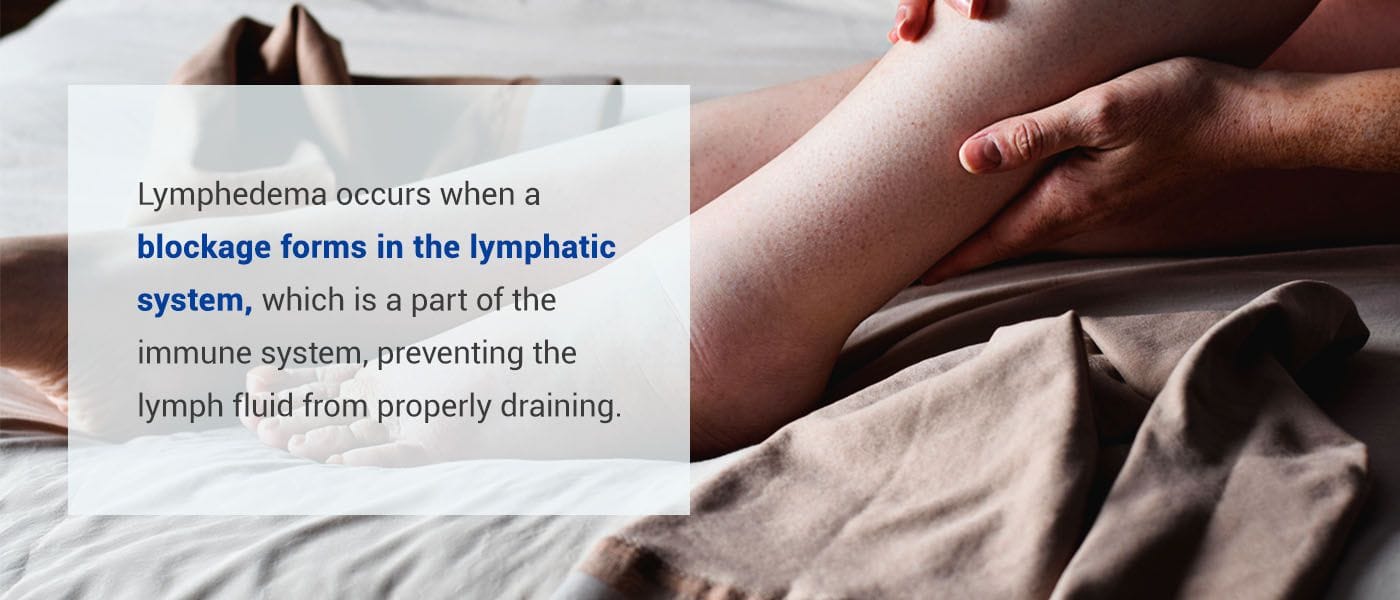Although lymphedema affects about one out of every 1,000 Americans, solutions for improving its symptoms are not commonly discussed. While the pain and swelling that come with lymphedema may seem permanent, many methods can help minimize lymphedema symptoms. Specifically, eating the right foods and dieting can greatly reduce the effects of lymphedema.
A healthy diet can help you maintain a healthy body weight and body mass index (BMI). While there is no specific diet that can treat lymphedema, making small nutritional and lifestyle changes can keep swelling and discomfort to a minimum. Keep reading to find out what a lymphedema diet consists of, along with other practical methods of coping with the condition.
Find Your Local Lymphedema Specialist
What Is Lymphedema?
Lymphedema is typically caused by lymph nodes being damaged or removed as a result of cancer treatment, such as surgery or radiation therapy. In fact, research indicates that breast cancer survivors have a 15-40% chance of developing breast-cancer related lymphedema (BCRL).
Although most often caused by cancer treatment, lymphedema may not appear until months or even years after the initial treatment. When lymphedema develops following treatment for another condition, this is known as secondary lymphedema.
Surgery, trauma and radiation treatments are secondary causes of lymphedema. Primary lymphedema is a genetic condition often caused by dysplasia of the lymphatic system or certain vascular abnormalities, such as:
- Klippel-Trenaunay-Weber syndrome
- Turner syndrome

Lymphedema Symptoms
Lymphedema occurs when a blockage forms in the lymphatic system, which is a part of the immune system, preventing the lymph fluid from properly draining. With nowhere else to go, the lymph fluid begins to build up and cause swelling. This swelling can range from mild, barely noticeable changes in limb size to intense swelling that makes the limb difficult to use.
Signs of lymphedema may include:
- Swelling: Swelling due to this condition can be in part or all of a leg or arm, including the toes or fingers.
- Fibrosis: Lymphedema can result in fibrosis, which is when the skin hardens or thickens.
- Limited flexibility: This condition may restrict your typical range of motion due to swelling and feeling of heaviness.
- Discomfort: Lymphedema may include sensations of heaviness or tightness along with aching or discomfort.
- Infections: Lymphedema may come with recurring infections.
Although there is currently no cure for lymphedema, an early diagnosis can make the symptoms quite manageable and reduce damage to the affected limbs.
Locate a Hospital Near You for Personalized Care
8 Dieting Tips for Improving Lymphedema Symptoms
Following a healthy diet can help reduce lymphedema symptoms by supporting a healthy body weight. Excessive amounts of body fat mean that the lymphatic system has a harder time draining and passing fluid properly. Consuming foods that can help combat both cancer and lymphedema, as well as avoiding foods that contribute to symptoms, can improve overall health.
Below are some dieting tips to improve lymphedema symptoms.
1. Drink Plenty of Water
Lymphedema affects the body’s ability to drain extracellular fluid from the tissues, causing buildup in the affected limbs. As a result, some patients with lymphedema believe that reducing water intake can reduce swelling and fluid accumulation. While this is a fair assumption, it actually has the opposite effect.
Drinking plenty of water can help manage lymphedema symptoms by promoting the body’s filtration and elimination functions. Being dehydrated causes your body to hold onto excess liquid, so staying hydrated supports your lymphatic system health.
It is important to note that lymphedema patients should not drink an excessive amount of water, since too many fluids can overwhelm the body and worsen swelling.
2. Avoid Caffeine, Alcohol, and Diuretics
A key part of staying hydrated is limiting beverages that contribute to dehydration, including coffee and alcohol. Additionally, it is important to avoid diuretics, also known as water pills.
While water pills can have some positive short-term effects by removing the water content of swelling, long-term use of diuretics can worsen lymphedema symptoms by causing dehydration by leaving a higher concentration of protein mass in the lymph fluid. This effect draws more water to the swollen area as soon as the diuretic wears off. If you are currently taking diuretics, be sure to check with your health care provider about your options before stopping them.
3. Keep Protein in Your Diet
Protein is essential to keeping your body healthy and fully functional. When you do not eat enough protein, fluid can seep from your bloodstream into your tissues, making lymphedema worse. For this reason, you should add healthy proteins into your regular diet, including:
- Seeds
- Nuts
- Beans
- Eggs
- Lentils
- Legumes
- Fish
- Poultry
- Lean meats
- Tofu
- Cottage cheese
It is important to consume enough protein daily to maintain your body’s fluid balance. The recommended amount of daily dietary protein is about 0.36 grams per pound of body weight. For instance, if you weigh 180 pounds, try to eat about 65 grams of protein daily. Keep in mind that this amount is only a recommendation depending on your unique needs and lifestyle.
4. Reduce Your Salt Intake
A large amount of salt can cause water retention in the body. The more sodium you consume, the more fluid your body holds onto. This extra fluid can exacerbate preexisting lymphedema symptoms.
Salt is most often found in processed foods, so you can limit your daily intake of sodium by avoiding canned foods, fast food, frozen and boxed meals, cured meats, and salty condiments. Make sure to read nutrition labels carefully to avoid excess sodium.
5. Incorporate More Whole Foods Into Your Diet
Whole foods are the best types of foods to eat for those with lymphedema because they are not processed. Unlike whole foods, processed foods undergo substantial modification and typically contain high levels of:
- Salt
- Sugar
- Soy
- Saturated fats
- Artificial colors
- Chemical additives
- Unnatural flavors
Diets high in processed foods leave less room for nutrient-dense foods that provide the vitamins, minerals, and antioxidants your body needs. Some examples of whole foods include:
- Fruits
- Vegetables
- Oats
- Brown rice
- Barley
- Nuts
- Beans
- Shellfish
- Eggs
If you cannot eat solid fruits and vegetables, juicing is an alternative option. However, juicing is not recommended if you can eat solid food because the process of juicing breaks down fiber, which is a valuable health benefit of whole foods. Fruit juices can also spike blood glucose levels more rapidly than whole fruits, so it is best to consult with your health care provider for the most appropriate way to consume whole foods for your unique needs.
6. Limit Refined Sugars
Along with incorporating whole foods into your diet, you should try to limit certain foods that can exacerbate lymphedema symptoms, including added sugars. The following foods are often high in refined sugars, preservatives, and fat that can contribute to increased inflammation in your body:
- White bread
- White rice
- White pasta
- Candy
- Cakes
- Chips
- Processed baked goods
- Fried foods
- Soda
- Sweetened tea
- Energy drinks
- Lemonade
- Frozen or microwavable meals
- Juices with added sugar
- Boxed meals
You can start limiting added sugars by swapping out sodas for flavored water or eating fruit instead of candy for dessert. You can also use some alternatives when you want to add a bit of sweetness to your meals, like:
- Honey
- Cinnamon
- Rapadura sugar
- Coconut sugar
7. Opt for Healthy Fats and Oils
Swap out processed butter and refined vegetable oils for healthier alternatives. For instance, olive oil contains a biophenol known as hydroxytyrosol, known for anti-inflammatory, antioxidant, and antimicrobial properties, which can be helpful for improving lymphedema-related symptoms.
Other healthy fats and oils include:
- Flaxseed oil
- Fish oil
- Organic butter
- Some coconut oils
- Hummus
- Greek yogurt
- Avocados
8. Prioritize Anti-Inflammatory Foods
Incorporating anti-inflammatory foods into your diet can help minimize the effects of lymphedema. Omega-3 fatty acids, for example, are known for their exceptional anti-inflammatory and immune-boosting properties. Flaxseed oil, which is rich in omega-3, is thought to deliver anticancer properties.
Anti-inflammatory dietary molecules can also help reduce edema, or fluid trapped in the body’s tissues, and contribute to your overall lymphatic health.
Foods plentiful in omega-3 fatty acids include:
- Avocados
- Chia seeds
- Flax seeds
- Pumpkin seeds
- Almonds
- Hemp seeds
- Walnuts
- Salmon
- Tuna
- Sardines
- Turmeric
- Garlic
Additional Ways to Manage Lymphedema Symptoms
In addition to following a healthy diet, you can do other things to keep lymphedema symptoms to a minimum. Combining a proper lymphedema diet with other strategies for managing lymphedema can help mitigate the condition’s effects.
Here are seven extra ways to manage lymphedema symptoms:
- Exercise: Regular exercise promotes joint motion, which can aid circulation and boost lymph vessel activity.
- Compression therapy: Compression therapy applies pressure from the outside, which can help filter fluid through the lymphatic system, helping to reduce lymphedema symptoms. There is also a variety of compression garments that may help between treatments. These garments provide pressure to prevent the buildup of lymphatic fluid in the affected area. A trained professional can help you find the appropriate compression garments and ensure they fit correctly.
- Massage therapy: As a different form of compression, massage therapy can help move fluid through the lymphatic system and alleviate swelling.
- Proper skin care: Keeping your skin clean is key for managing lymphedema. Practice good skin hygiene and keep a close watch on your arm and leg skin so you can spot any changes or breaks in the skin early. If you have a cut or scrape, take care of it quickly. Catching these issues early can help prevent infection.
- Wear loose clothing: Avoid wearing tight articles of clothing that could constrict your leg or arm and restrict the lymphatic system.
- Avoid extreme heat or cold: Try not to expose the affected area or swollen arm or leg to extreme temperatures. For example, avoid going into a sauna or applying ice or a heating pad to the area.
- Elevate your limb: Try to elevate the affected arm or leg above the level of your heart whenever possible. At night, you can also place a pillow under the affected leg or arm while sleeping.

Learn More About Managing Lymphedema With PAM Health
A comprehensive lymphedema treatment program will provide you with all the tools and techniques you need to manage your lymphedema symptoms. At PAM Health, patients can benefit from a full range of lymphedema therapies, from manual lymphatic drainage to compression therapy. With individualized treatment plans, therapists work with patients to tweak them as needed.
These programs can teach patients how to put on compression garments, advise on which ones will work best, and educate family members on the best ways to offer support. In addition to relieving physical discomfort, therapists can offer emotional support. Our therapists are experienced professionals that understand your condition and the mental toll it can take. They will listen to your experiences and concerns, and focus on solutions tailored to your unique needs.
PAM Health focuses on delivering patients the highest quality care possible to achieve long-term positive outcomes. The dedicated and caring staff at PAM Health will work with you to develop a treatment plan that reduces the pain caused by lymphedema and improve your quality of life.
To get started on reducing the effects of your lymphedema today, contact the PAM Health location nearest you.
Find a PAM Health Location Near You


